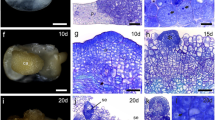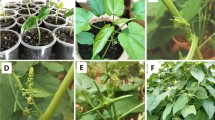Abstract
Pityopus californicus (Eastw.) H. F. Copel., a monotypic member of the Monotropoideae in the family Ericaceae, is a myco-heterotrophic species with distribution limited to the Pacific Northwest of the USA. Young embryos of P. californicus developed mycorrhizal associations in seed packets that had been buried for up to 681 days, suggesting that seeds of P. californicus may require the presence of a fungus to achieve germination. Samples of nongerminated seeds and early stages in embryo and root development were subsequently processed for light microscopy, histochemistry, and transmission electron microscopy (TEM). Nongerminated seeds possessed a thick testa, lacked a shoot and root meristem, and consisted of an embryo with large parenchymatous cells containing protein bodies and starch grains as storage reserves. In the earliest developmental stage (seed coat still attached), fungal hyphae were present on the testa surface and between the testa and embryo. This stage was followed by embryo elongation, the organization of a root apical meristem, and the development of a well-developed fungal mantle surrounding the elongated embryo. At least two morphotypes were identified based on structural characteristics of the mantle. One of these, with ascomycetous septa, had Cenococcum-like features. Late-stage embryo/early root development revealed a typical mantle and Hartig net, with fungal pegs penetrating the outer tangential walls of epidermal cells. Transfer cell-like deposits of wall material, similar to those described in Monotropa spp., enclosed fungal pegs. The development of a Hartig net and fungal pegs suggests that nutrient exchange interfaces are required for seedling development.




Similar content being viewed by others
References
Bidartondo M (2005) Tansley review. The evolutionary ecology of myco-heterotrophy. New Phytol 167:335–352
Bidartondo MI, Bruns TD (2001) Extreme specificity in epiparasitic Monotropoideae (Ericaceae): widespread phylogenetic and geographical structure. Mol Ecol 10:2285–2295
Bidartondo MI, Bruns TD (2002) Fine-level mycorrhizal specificity in the Monotropoideae (Ericaceae): specificity for fungal species groups. Mol Ecol 11:557–569
Bidartondo MI, Bruns TD (2005) On the origins of extreme mycorrhizal specificity in the Monotropoideae (Ericaceae): performance trade-offs during seed germination and seedling development. Mol Ecol 14:1549–1560
Bruns TD, Read DJ (2000) In vitro germination of non-photosynthetic, myco-heterotrophic plants stimulated by fungi isolated from the adult plants. New Phytol 148:335–342
Bücking H, Heyser W (2001) Microautoradiographic localization of phosphate and carbohydrates in mycorrhizal roots of Populus tremula × Populus alba and the implications for transfer processes in ectomycorrhizal associations. Tree Physiol 21:101–107
Copeland HF (1935) On the genus Pityopus. Madroño 3:154–168
Culling CFA (1974) Modern microscopy: elementary theory and practice. Butterworths, London
Dexheimer J, Gérard J (1993) Application de quelques techniques cytochimiques à l’étude des interfaces des ectendomycorhizes de Monotrope (Monotropa hypopitys L.). Acta Bot Gall 140:459–472
Dexheimer J, Pargney J-C (1991) Les interfaces des mycorhizes. Un exemple d’interactions pariétales. Bull Soc Bot Fr 138:243–255
Duddridge JA, Read DJ (1982) An ultrastructural analysis of the development of mycorrhizas in Monotropa hypopitys L. New Phytol 92:203–214
Heath MC (1997) Signalling between pathogenic rust fungi and resistant or susceptible host plants. Ann Bot 80:713–720
Leake JR (1994) Tansley review no 69. The biology of myco-heterotrophic (‘saprophytic’) plants. New Phytol 127:171–216
Leake JR (2005) Plants parasitic on fungi: unearthing the fungi in myco-heterotrophs and debunking the ‘saprophytic’ plant myth. Mycologist 19:113–122
Leake JR, McKendrick SL, Bidartondo M, Read DJ (2004) Symbiotic germination and development of the myco-heterotroph Monotropa hypopitys in nature and its requirement for locally distributed Tricholoma spp. New Phytol 163:405–423
Lutz RW, Sjolund RD (1973) Monotropa uniflora: ultrastructural details of its mycorrhizal habit. Am J Bot 60:339–345
Massicotte HB, Melville LH, Peterson RL (2005) Structural features of mycorrhizal associations in two members of the Monotropoideae, Monotropa uniflora and Pterospora andromedea. Mycorrhiza 15:101–110
Matsuda Y, Yamada A (2003) Mycorrhizal morphology of Monotropastrum humile collected from six different forests in central Japan. Mycologia 95:993–997
Mims CW, Rodriguez-Lother C, Richardson EA (2001) Ultrastructure of the host-parasite interaction in leaves of Duchesnea indica infected by the rust fungus Frommeë mexicana var. indicae as revealed by high pressure freezing. Can J Bot 79:49–57
Peterson RL, Massicotte HB (2004) Exploring structural definitions of mycorrhizas, with emphasis on nutrient-exchange interfaces. Can J Bot 82:1074–1088
Peterson RL, Uetake Y, Zelmer C (1998) Fungal symbioses with orchid protocorms. Symbiosis 25:29–55
Ruzin SE (1999) Plant microtechnique and microscopy. Oxford University Press, Oxford, UK
Smith SE, Read DJ (1997) Mycorrhizal symbiosis, 2nd edn. Academic Press, London, UK
Strullu DG, Gerault A (1977) Étude des ectomycorhizes à basidiomycètes et à ascomycètes du Betula pubescens (Ehrh.) en microscopie électronique. C R Acad Sci Paris pp 2243–2246
Taylor DL, Bruns TD, Leake JR, Read DJ (2002) Mycorrhizal specificity and function in myco-heterotrophic plants. In: van der Heijden MGA, Sanders I (eds) Mycorrhizal ecology. Ecological studies, vol 157. Springer, Berlin Heidelberg New York, pp 375–413
Acknowledgements
We thank Martin Bidartondo for his generosity in supplying the samples used in this study, as well as two anonymous reviewers who contributed valuable insights to the discussion. Financial support was provided by the Natural Sciences and Engineering Research Council of Canada to HBM and RLP.
Author information
Authors and Affiliations
Corresponding author
Rights and permissions
About this article
Cite this article
Massicotte, H.B., Melville, L.H., Tackaberry, L.E. et al. Pityopus californicus: structural characteristics of seed and seedling development in a myco-heterotrophic species. Mycorrhiza 17, 647–653 (2007). https://doi.org/10.1007/s00572-007-0142-5
Received:
Accepted:
Published:
Issue Date:
DOI: https://doi.org/10.1007/s00572-007-0142-5




